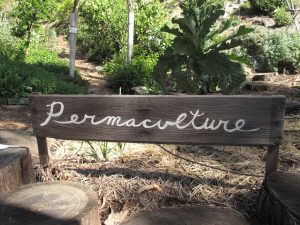The principles of Permaculture design are largely based on the study of natural ecosystems and their ecology. Various Permaculture texts use different names and groupings, which can be a bit confusing! This list is not intended to be comprehensive; it refers to the key principles only (as defined by me!).
-
Use natural patterns – Learn from how nature does things and try to imitate it. An example of this might be the establishment of perennial and no dig gardens. In some ways we could say that all the other principles come from this approach.
-
Work with not against nature – One of the ideas here is after careful observation to make the least change necessary for greatest effect in terms of what we want, ie a minimum intervention approach [eg grow something like willow (for basketry/fuel) that enjoys boggy ground instead of draining it to grow field crops].
-
Establish low maintenance systems (The 80:20 principle) – It is better to put more work/energy in at the beginning to establish low maintenance systems rather than for systems to be high maintenance [eg it is better to modify a home to be energy efficient than to have to use a lot of energy heating it]. This applies to the design phase too: “prolonged and thoughtful observation rather than prolonged and thoughtless labour”. An established system should be designed have high outputs relative to the inputs, both in terms of material/energy and labour; this should be applied whether we are looking at intensive systems or more extensive ones.
-
Use diversity – A well-designed diverse system is more productive and stable than a ‘monoculture’.
-
Maximise beneficial relationships – This principle is about integration. Select things that will work well together so that the needs of something can be met by the output of something else. Also locate things so that beneficial connections exist between them, an idea known as relative location.
-
Multi-function – Each thing in a design should perform many functions. As a guideline everything should have at least three functions.
-
Important function to be supported by many components – In other words don’t put all your eggs in one basket. We should not rely on a single source of food, water or energy if we want to avoid famines etc. The Irish potato famine, where people relied almost exclusively on potatoes for food is a good example of what can happen when you rely on a single food source [historical note: barley was also extensively grown at the same time as potatoes but was used to pay rent/taxes].
-
Stacking – Use of three dimensional space, for example a forest garden where fruit bushes can be grown under fruit trees with fertility maintaining ground cover plants around them.
-
Use edge effect – The edge between 2 ecosystems (eg water and land or open ground and woodland) is more diverse and more productive. It contains most of the species of both ecosystems plus some that only live on the edge. Also fertility accumulates here (eg wind blown leaves). In addition some of the limiting factors to be found in each ecosystem will not be present on the edge (eg in the instance of open ground and woodland there may be plenty of light and shelter from the wind). Ecologically the edge effect is known as the ecotone. In most instances we will want to increase both the length and ‘depth’ of edges (eg the edge between orchard and garden can be made longer by making it curvy and wider by stepping it down from larger trees to smaller ones then shrubs). Not all edges have beneficial interactions, eg the outside of a house where heat is lost or the edge between vegetable beds and invasive weeds, these edges should be minimised!
-
Use or mimic natural succession – In nature all ecosystems move towards a more stable mature state, which is highly productive, for example woodland, which on land are almost always diverse and comprise of perennial plants and huge populations of micro-organisms. Our challenge is to design systems that are as productive and stable in terms of meeting our needs whilst requiring little in the way of inputs. For example an orchard is as productive as a field of carrots but requires fewer inputs of energy and effort and little or no inputs of fertility. In nature various plants have a place in a natural succession. We must learn to do the same; starting from where we are with each stage preparing the way for the next stage and a succession of different yields. This is as true of the design of organisations as it is of a garden!
-
Use and improve microclimates – Eg. Planting against a sunny wall or sheltering with hedges or trees.
-
Cycling and recycling of resources and energies – We should maximise the use of energy and materials from source to sink, ie from where they become available to us to where we loose them from our system. Thinking about reusing water many times is the easiest way to think about this but it applies just as much to fertility in a garden or money in the local economy.
-
Energy efficient planning – Zones, sectors, etc.
-
Imagination is the only limit to yield – The concept that yield is almost unlimited seems strange, but the concept here is that whilst we can keep thinking of ways to get more uses out of something [here uses = yields] then we can get more out of it. How many uses can an apple tree in a garden or a community hall have?
[Thanks to Bryn Thomas of Brighton Permaculture Trust for info.]

